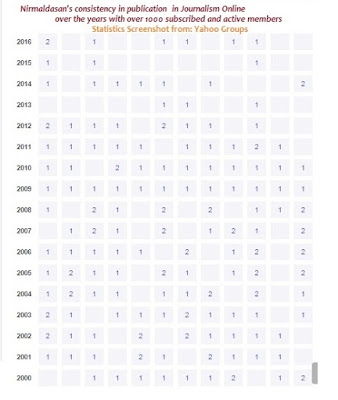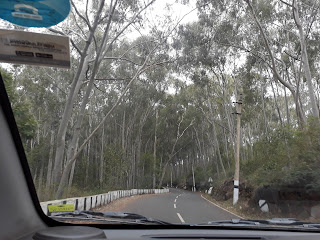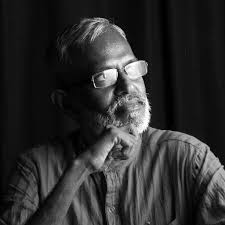Friday 30 December 2016
Kudos!
Wednesday 28 December 2016
At last! 'Critical Voices' is ready to roll...
Thursday 22 December 2016
A Featured Inspirational on #Nirmaldasan
 |
| click on pic to enlarge |
Wednesday 21 December 2016
Youth Leaders Travel and Learning Camp 2017
Adversity and Resilience: Reminiscences on Cyclone Vardah and MCC
 |
| Selaiyur Hall #postVardah |
Monday 19 December 2016
The Hills are Alive...
 And that’s exactly what we did,
when the government of TN announced a ‘Cyclone Holiday’ for Monday, 12 December,
in anticipation of Cyclone Vardah. Since the next day happened to be Milad
un-Nabi, and hence a gazetted holiday, we – a ‘trek-crazy-collective’ -
brainstormed the whole of Sunday night and yes! we were quite restive on an
otherwise resty day! Soon we were on our toes, planning and scoring out all our
options and in no time had our plans afoot! Yep! We’d decided to be outta namma Chennai for a two-day trek through
three wonderful hills as part of the huge Eastern-Ghats-chains’-conglomerate.
And that’s exactly what we did,
when the government of TN announced a ‘Cyclone Holiday’ for Monday, 12 December,
in anticipation of Cyclone Vardah. Since the next day happened to be Milad
un-Nabi, and hence a gazetted holiday, we – a ‘trek-crazy-collective’ -
brainstormed the whole of Sunday night and yes! we were quite restive on an
otherwise resty day! Soon we were on our toes, planning and scoring out all our
options and in no time had our plans afoot! Yep! We’d decided to be outta namma Chennai for a two-day trek through
three wonderful hills as part of the huge Eastern-Ghats-chains’-conglomerate. Early next morning - in
the chilly margazhi-eve blistering
colds, on the auspicious day of the Festival of Lights – Thirukaarthigai Deepam – when households are beautifully arrayed in
the agal villakus (lamps) – we
ventured out at around 5 am, nine of us – all geared up, - arrayed in our linen
jackets/blazers to ward off the prospective cold winds, - and got into our
vehicles at 5.10 am sharp - two pretty little hatchbacks!
Early next morning - in
the chilly margazhi-eve blistering
colds, on the auspicious day of the Festival of Lights – Thirukaarthigai Deepam – when households are beautifully arrayed in
the agal villakus (lamps) – we
ventured out at around 5 am, nine of us – all geared up, - arrayed in our linen
jackets/blazers to ward off the prospective cold winds, - and got into our
vehicles at 5.10 am sharp - two pretty little hatchbacks! Bumpy terrains aside, we were
thinking back about namma Chennai, and yes I should admit that, we weren’t in
the least mindful of cyclone Vardah, as we were all of the ‘considered opinion’
that it could be just ‘yet another’ weakiest of Nadas, - the frail cyclone Nada
- that had failed to enthuse the rain clouds to water-starved Chennai, in the
first week of December!
Bumpy terrains aside, we were
thinking back about namma Chennai, and yes I should admit that, we weren’t in
the least mindful of cyclone Vardah, as we were all of the ‘considered opinion’
that it could be just ‘yet another’ weakiest of Nadas, - the frail cyclone Nada
- that had failed to enthuse the rain clouds to water-starved Chennai, in the
first week of December!  |
| #Vellore Fort - a side view |
Sunday 18 December 2016
Preparation for NET/JRF - 17
Saturday 17 December 2016
On Dr. Premila Paul's Talk @ MCC
| Dr. Premila Paul had us all in splits... |
Well, Dr. Premila's talk had us all in splits all through. Her take on MCC and its myriad sagas of love, our Princi's connection with Madurai and a panoramic sweep of Anita Nair's oevre etc., were lively and peppy all the way!
Friday 16 December 2016
Preparation for NET/JRF - 16
 After the great
upheaval caused by the transformation of industry, after the religious
awakening of Methodism and Evangelicalism, the decisive shock to thought comes
with the French Revolution. It is legitimate enough to date the beginning of
the new age in literature from the publication of the anonymous work which
united the young talents of Wordsworth and Coleridge (1798). Romanticism in
England is the affirmation of an innovatory aesthetic creed, as opposed to
orthodox art. English Romanticism does not consist in the triumph of ‘self’.
The personality of the writer has a characteristic place in it, because
sensibility and imagination are of the very essence of individuality.
Classicism laid stress upon the impersonal aspects of the life of the mind; the
new literature, on the other hand, openly shifts the centre of art, bringing it
back towards what is most proper and particular in each individual.
After the great
upheaval caused by the transformation of industry, after the religious
awakening of Methodism and Evangelicalism, the decisive shock to thought comes
with the French Revolution. It is legitimate enough to date the beginning of
the new age in literature from the publication of the anonymous work which
united the young talents of Wordsworth and Coleridge (1798). Romanticism in
England is the affirmation of an innovatory aesthetic creed, as opposed to
orthodox art. English Romanticism does not consist in the triumph of ‘self’.
The personality of the writer has a characteristic place in it, because
sensibility and imagination are of the very essence of individuality.
Classicism laid stress upon the impersonal aspects of the life of the mind; the
new literature, on the other hand, openly shifts the centre of art, bringing it
back towards what is most proper and particular in each individual. Thursday 15 December 2016
Derrida's 'Structure, Sign & Play' - A Critical Summary
Thursday 8 December 2016
Books - the Secret of Amma's Energy
‘Alice in Wonderland?’
That’s how we felt, my sisters and I, completely dwarfed by the floor-to-ceiling array of books, and a very tall step ladder with a perch on top, standing against one shelf-wall.
I heard my oldest sibling whisper to my Dad,
“Are these real books?” I tugged at his sleeve: “Appa, please may I climb the ladder and sit on top?”
Jayalalithaa, then perhaps in her twenties, had ushered us into her brand new home at Poes Gardens, and she was showing us around.
My father, Tamil film actor Gemini Ganesan, had asked if he could show the place to his “girls”, especially the library that she had apparently described to him with great passion.
The books were indeed ‘real’ and she had an amazing collection of English classics - Shakespeare, Dickens, Kingsley, Hardy, Tennyson, Bronte, Wilde, and more.
The Dickens collection among a few others was leather-bound, embossed with gold letters.
Which is why I smiled, as I watched Jennifer Arul’s interview with Jayalalithaa on NDTV - re-telecast after Amma’s death - in which the former CM said,
“My dream is to retire to my farm, surround myself with books and read them, listen to music, with my dogs, and perhaps do some agriculture. Far from the madding crowd.”
It wasn’t said for effect. She really meant it. And she had read Thomas Hardy.
Jayalalithaa was not always ‘Amma’.
She was called ‘Ammu’ (dearest one) at home, and her Mom sent her to the best schools available then, both in Bangalore (Bishop Cottton) and Madras, Presentation Convent, Church Park, where I was in junior school when Jayalalithaa was in her final year, matriculation.
Her long, straight hair, that she wore in a single loose plait, would gently swing like a pendulum well below her hips as she walked across the school grounds, the sun catching the largish golden hoops she wore in her ears.
With her porcelain skin, impeccable manners and dignified gait, Jayalalithaa stole many a heart but the teachers in school loved her for something else - she was their star pupil.
“Do you think you are Jayalalithaa that you can read comics in my class under the desk and still stand first?” So saying, Miss Edwards, the geography teacher, snatched my comic and threw it aside.
That was the kind of reputation Tamil Nadu’s Amma had at school - a brilliant student who could walk away effortlessly with flying colours!
It’s common knowledge now that Jayalalithaa never wanted to become an actress; she never wished to enter politics - yet she made a big name for herself in both.
She once mentioned that she was very keen to study English Literature. Others say she wanted to become a lawyer.
Whatever might have been her choice of career, there can be no doubt that she would have stood head and shoulders above others, perhaps far exceeding her performances in both films and politics.
(The writer was in junior school in Presentation Convent, then Madras, when J Jayalalithaa was in final year).
Source: Times of India, 08 December 2016, Chennai Edition.
The same columnist Ms Narayani Ganesh has also written an article on her dad - Actor Gemini Ganesan, in one of the past issues of the MCC magazine.
You may find the same on our blog HERE














